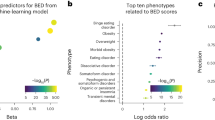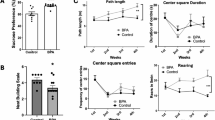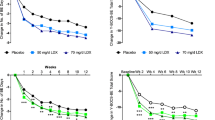Abstract
Response to psychomotor stimulants is highly variable across individuals. Such inconsistencies are influenced by many factors including drug dose and polymorphic differences in genes that encode proteins, such as the dopamine transporter (DAT1), which are relevant to the site of action of these substances. The current study used a double blind, crossover (methylphenidate vs placebo) design to assess DAT1 genotype differences on appetite ratings to a snack-food cue in subjects with binge eating disorder (BED) (n=32) and healthy age-matched controls (n=46). ANOVA results indicated a significant genotype × diagnostic group interaction whereby BED subjects with at least one copy of the 9-repeat allele showed a significant suppression of appetite in response to methylphenidate compared with controls with this allele, or to subjects with the 10/10 genotype (irrespective of diagnosis) whose drug response was indistinguishable from placebo. The most probable explanation for these findings is that some, currently unknown, genetic variant, which is overrepresented in those with BED, interacts with DAT1 to suppress appetite in response to stimulant administration. The current findings have implications for treatment response to drugs currently in use (or being developed) for the treatment of overeating and overweight.
Similar content being viewed by others
Log in or create a free account to read this content
Gain free access to this article, as well as selected content from this journal and more on nature.com
or
References
American Psychiatric Association (1994). Diagnostic and Statistical Manual—Version IV. American Psychiatric Association Press: Washington.
Bellgrove MA, Hawi Z, Kirley A, Fitzgerald M, Gill M, Robertson IH (2005). Association between dopamine transporter (DAT1) genotype, left-sided inattention, and an enhanced response to methylphenidate in attention-deficit hyperactivity disorder. Neuropsychopharmacology 30: 2290–2297.
Berridge KC (2003). Pleasures of the brain. Brain Cogn 52: 106–128.
Bina KG, Cincotta AH (2000). Dopaminergic agonists normalize elevated hypothalamic neuropeptide Y and corticotropin-releasing hormone, body weight gain, and hyperglycemia in ob/ob mice. Neuroendocrinology 71: 68–78.
Cochrane C, Malcolm R, Brewerton T (1998). The role of weight control as a motivator for cocaine abuse. Addict Behav 23: 201–207.
Cohen MX, Young J, Baek J-M, Kessler C, Ranganath C (2005). Individual differences in extraversion and dopamine genetics predict neural reward responses. Cogn Brain Res 25: 851–861.
Corwin RL (2006). Bingeing rats: a model of intermittent excessive behavior? Appetite 46: 11–15.
Cubells JF, Kranzler HR, McCance-Katz E, Anderson GM, Malison RT, Price LH et al (2000). A haplotype at the DBH locus, associated with low plasma dopamine β-hydroxylase activity, also associates with cocaine-induced paranoia. Mol Psychiatry 5: 56–63.
Davis C, Levitan RS, Smith M, Tweed S, Curtis C (2006). Associations among overeating, overweight, and attention deficit/hyperactivity disorder: a structural equation modelling approach. Eating Behav 7: 266–274.
Davis C, Patte K, Levitan RS, Reid C, Tweed S, Curtis C (2007) From motivation to behavior: a model of reward sensitivity, overeating, and food preferences in the risk profile for obesity. Appetite 48: 12–19.
Davis C, Strachan S, Berkson M (2004). Sensitivity to reward: Implications for overeating and overweight. Appetite 42: 131–138.
Davis C, Tweed S, Curtis C (2005). Decision-making deficits and personality risk factors: an addiction model of binge eating. Presentation at the Annual Meeting of the Eating Disorder Research Society, Toronto, September.
Davis C, Woodside DB (2002). Sensitivity to rewarding effects of food and exercise in the eating disorders. Compr Psychiatry 43: 189–194.
Depue RA, Collins PF (1999). Neurobiology of the structure of personality: dopamine, facilitation of incentive motivation, and extraversion. Behav Brain Sci 22: 491–517 (Discussion 518–569).
Epstein LH, Jaroni JL, Paluch RA, Leddy JJ, Vahue HE, Hawk L et al (2002). Dopamine transporter genotype as a risk factor for obesity in African-American smokers. Obes Res 10: 1232–1240.
Epstein LH, Wright SM, Paluch RA, Leddy JJ, Hawk Jr LW, Jaroni JL et al (2004). Relation between food reinforcement and dopamine genotypes and its effect on food intake in smokers. Am J Clin Nutr 80: 82–88.
Evans AH, Lawrence AD, Potts J, MacGregor L, Katzenschlager R, Shaw K et al (2006). Relationship between impulsive sensation seeking traits, smoking, alcohol and caffeine intake, and Parkinson's disease. J Neurol Neurosurg Psychiatry 77: 317–321.
Fairburn CG, Cooper Z (1993). The eating disorder examination. In: Fairburn CG, Wilson GT (eds). Binge Eating: Nature, Assessment, and Treatment. Guilford Press: New York. pp 317–360.
Franken IHA, Muris P (2005). Individual differences in reward sensitivity are related to food craving and relative body weight in healthy women. Appetite 45: 198–201.
Gelernter J, Kranzler HR, Satel SL, Rao PA (1994). Genetic association between dopamine transporter protein alleles and cocaine-induced paranoia. Neuropsychopharmacology 11: 195–200.
Kelley AE, Schiltz CA, Landry CF (2005). Neural systems recruited by drug- and food-related cues: studies of gene activation in corticolimbic regions. Physiol Behav 86: 11–14.
Kirley A, Lowe N, Hawi Z, Mullins C, Daly G, Waldman I et al (2003). Association of the 489 bp DAT1 allele with methylphenidate response in a sample of Irish children with ADHD. Am J Med Genet Part B 121B: 50–54.
Krause J, la Fougere C, Krause K-H, Ackenheil M, Dresel SH (2005). Influence of striatal dopamine transporter availability on the response to methylphenidate in adult patients with ADHD. Eur Arch Psychiatry Clin Neurosci 255: 428–431.
Kreek MJ, Bart G, Lilly C, LaForge KS, Nielson DA (2005). Pharmacogenetics and human molecular genetics of opiate and cocaine addictions and their treatments. Pharmacol Rev 57: 1–26.
Kuo DY (2002). Co-administration of dopamine D-1 and D-2 agonists additively decreases daily food intake, body weight and hypothalamic neuropeptide y level in rats. J Biomed Sci 9: 126–132.
Leddy JJ, Epstein LH, Jaroni JL, Roemmich JN, Paluch RA, Goldfield GS et al (2004). Influence of methylphenidate on eating in obese men. Obes Res 12: 224–232.
Lerman C, Berrettini W (2003). Elucidating the role of genetic factors in smoking behavior and nicotine dependence. Am J Med Genet 118B: 48–54.
Lott DC, Kim S-J, Cook Jr EH, de Wit H (2005). Dopamine transporter gene associated with diminished subjective response to amphetamine. Neuropsychopharmacology 30: 602–609.
Moyers SB (2005). Medications as adjunct therapy for weight loss: approved and off-label agents in use. J Amer Diet Assoc 105: 948–959.
Nicola SM, Taha SA, Kim SW, Fields HL (2005). Nucleus accumbens dopamine release is necessary and sufficient to promote the behavioral response to reward-predictive cues. Neurosci 135: 1025–1033.
Parker BA, Ludher AK, Loon TK, Horowitz M, Chapman IM (2004a). Relationships of rating of appetite to food intake in healthy older men and women. Appetite 43: 227–233.
Parker BA, Sturm K, MacIntosh CG, Feinle C, Horowitz M, Chapman IM (2004b). Relation between food intake and visual analogue scale ratings of appetite and other sensations in healthy older and younger subjects. Eur J Clin Nutr 58: 212–218.
Shinohara M, Mizushima H, Hirano M, Shioe K, Nakazawa M, Hiejima Y et al (2004). Eating disorders with binge-eating behaviour are associated with the s allele of the 3′-UTR VNTR polymorphism of the dopamine transporter gene. J Psychiatry Neurosci 29: 134–137.
Stein MA, Waldman ID, Sarampote CS, Seymour KE, Robb AS, Conlon C et al (2005). Dopamine transporter genotype and methylphenidate dose response in children with ADHD. Neuropsychopharmacology 30: 1374–1382.
Timberlake DS, Haberstick BC, Hopfer C, Lessem JM, Smolen A, Ehringer M et al (2006). An association between the DAT1 polymorphism and smoking behavior in young adults from the National Longitudinal Study of Adolescent Health. Health Psychol 25: 190–197.
Vandenbergh DJ, Persico AM, Hawkins AL, Griffin CA, Li X, Jans EW et al (1992). Human dopamine transporter gene (DAT1) maps to chromosome 5p15.3 and displays a VNTR. Genomics 14: 1104–1106.
VanNess SH, Owens MJ, Kilts CD (2005). The variable number of tandem repeats element in DAT1 regulates in vitro dopamine transporter density. BMC Genetics 5: 55 doi:10.1186/1471-2156-6-55.
Volkow ND, Wang G-J, Fowler JS, Logan J, Gatley SJ, Gifford A et al (1999). Prediction of reinforcing responses to psychostimulants in humans by brain dopamine D2 receptor levels. Am J Psychiatry 156: 1440–1443.
Volkow ND, Wang G-J, Fowler JS, Logan J, Jayne M, Francesschi D et al (2002). ‘Nonhedonic’ food motivation in humans involves dopamine in the dorsal striatum and methylphenidate amplifies this effect. Synapse 44: 175–180.
Wang GJ, Volkow ND, Thanos PK, Fowler JS (2004). Similarity between obesity and drug addiction as assessed by neurofunctional imaging: a concept review. J Affect Disord 23: 39–53.
Yun IA, Wakabayashi KT, Fields HL, Nicola SM (2004). The ventral tegmental area is required for the behavioral and nucleus accumbens neuronal firing responses to incentive cues. J Neurosci 24: 2923–2933.
Zangen A, Solinas M, Ikemoto S, Goldberg SR, Wise RA (2006). Two brain areas for cannabinoid reward. J Neurosci 26: 4901–4907.
Acknowledgements
Project funding was provided by the Canadian Institute of Health Research.
Author information
Authors and Affiliations
Corresponding author
Rights and permissions
About this article
Cite this article
Davis, C., Levitan, R., Kaplan, A. et al. Dopamine Transporter Gene (DAT1) Associated with Appetite Suppression to Methylphenidate in a Case–Control Study of Binge Eating Disorder. Neuropsychopharmacol 32, 2199–2206 (2007). https://doi.org/10.1038/sj.npp.1301348
Received:
Revised:
Accepted:
Published:
Issue date:
DOI: https://doi.org/10.1038/sj.npp.1301348
Keywords
This article is cited by
-
Neural circuit control of innate behaviors
Science China Life Sciences (2022)
-
The association of insertions/deletions (INDELs) and variable number tandem repeats (VNTRs) with obesity and its related traits and complications
Journal of Physiological Anthropology (2017)
-
Genetic Similarities between Compulsive Overeating and Addiction Phenotypes: A Case for “Food Addiction”?
Current Psychiatry Reports (2015)
-
Association of a carboxylesterase 1 polymorphism with appetite reduction in children and adolescents with attention-deficit/hyperactivity disorder treated with methylphenidate
The Pharmacogenomics Journal (2013)
-
Reward circuitry dysfunction in psychiatric and neurodevelopmental disorders and genetic syndromes: animal models and clinical findings
Journal of Neurodevelopmental Disorders (2012)



